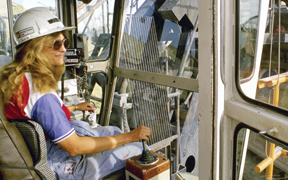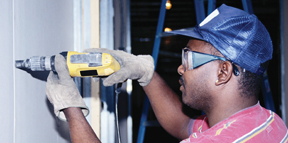By Seth J. Bookey
Contributing Editor
 Workers in a variety of settings are vulnerable to eye injuries, whether they are working with pneumatic tools, high-speed equipment, chemicals or electricity. While a variety of safety gear is required by law, the employee who looks after colleagues with prescription eyewear needs has some extra requirements to fulfill. Safety directors and registered nurses on site need to do more than check and see if people have their feet in the right kind of rubber boots or their earplugs in properly. Overseeing a safety prescription eyewear program also requires working with someone--be it an eyecare professional, a lab, or a safety eyewear manufacturer--who can streamline the process and keep them up-to-date on the latest safety eyewear requirements mandated by law. Whether the employees are fitted on site, or going to a local ECP, it usually boils down to one busy person on staff who has to ensure the workers’ visual safety.
Workers in a variety of settings are vulnerable to eye injuries, whether they are working with pneumatic tools, high-speed equipment, chemicals or electricity. While a variety of safety gear is required by law, the employee who looks after colleagues with prescription eyewear needs has some extra requirements to fulfill. Safety directors and registered nurses on site need to do more than check and see if people have their feet in the right kind of rubber boots or their earplugs in properly. Overseeing a safety prescription eyewear program also requires working with someone--be it an eyecare professional, a lab, or a safety eyewear manufacturer--who can streamline the process and keep them up-to-date on the latest safety eyewear requirements mandated by law. Whether the employees are fitted on site, or going to a local ECP, it usually boils down to one busy person on staff who has to ensure the workers’ visual safety.
Tailoring Safety Needs
Steve Grandstaff, who is the health, safety and environmental coordinator for Weyerhaeuser’s plant in Lynchburg, Va., oversees the safety needs of the 180 employees on site. The packaging plant is part of the shipping and container division and what might seem like an ordinary “box factory” poses a variety of dangers to the employees’ eyes.
 |
| Steve Grandstaff |
“There’s dust in the air. There is potential for raw corners, which are sharp. The use of tooling for setting up the machines is also dangerous. Repair work and preventive maintenance also might create airborne projectiles that can blind someone. We also do some work on miniature grinding wheels, too,” Grandstaff told VM, outlining the many hazards workers’ eyes might face on any day.
Grandstaff’s employees are entitled to new safety eyewear every two years, and can also get new lenses if there is a significant change in prescription.
When a change to a standard for work done in electrical cabinets was instituted recently, requiring no metal parts on eyewear, Grandstaff’s sales rep from Titmus Optical came into the plant. She met with the maintenance managers and gave him information on the newly required nonmetal safety frames. “She will do the training for the entire plant. I utilize Titmus to help me out with all the latest changes,” he noted. “They also came in to do demos to show the impact on a polycarbonate lens versus a plastic lens [when the ANSI standard changed in 2003].”
Dennis Sershen, safety director at SPX Corp. in Owatonna, Minn., oversees 1,000 employees’ safety needs, and in general, “we pay 100 percent for their safety glasses,” he told VM.
 SPX, a manufacturer of tolls and electronics for the automotive industry, works with Essilor for its safety eyewear needs. Employees use a single authorization form and can go to any ECP in the southeastern Minnesota area for fittings. “The forms are faxed to Essilor and within a week, they have glasses ready for adjustment,” he noted.
SPX, a manufacturer of tolls and electronics for the automotive industry, works with Essilor for its safety eyewear needs. Employees use a single authorization form and can go to any ECP in the southeastern Minnesota area for fittings. “The forms are faxed to Essilor and within a week, they have glasses ready for adjustment,” he noted.
SPX offers employees new lenses annually and new frames every other year; glasses damaged on the job are replaced immediately. Sideshields are mandatory. “We want to make sure the glasses are good. Your eyes are a priority,” Sershen added.
Sershen finds that the trend toward more stylish frames has helped employees comply better with eyewear requirements. The company offers 12 to 14 training modules and eyewear is covered along with all other workplace safety issues. He also gets feedback from employees as well. “When I see a damaged lens, I know the employees are very aware of how they might have lost their eyesight if it weren’t for safety eyewear,” he said. “We do have a lot of impacts, and we don’t have injuries because we provide safety eyewear. At least 12 to 15 accidents--some very severe--have been prevented thanks to the eyewear,” he added.
Sershen has worked at SPX for five years, and has been in the safety field for 25 years. “The key thing is service. Essilor is superior as far as service. They call on us a lot, and if there’s a problem, it becomes a priority for them,” he told VM. By working with Essilor for safety lenses, SPX has access to “the latest technology” in terms of AR lenses and scratch-resistent coatings.
Stacey Capps, RN, is an industrial occupational safety and health nurse at Masonite Corporation’s plant in Dixon, Tenn., where she looks oversees 300 employees; of whom 20 percent have prescription eyewear needs. The plant manufactures exterior doors and “there’s a lot of sawdust, flying objects, saws, and sheet metal” that might injure or blind an employee, she noted. Another hazard is the liquid foam that is sprayed on doors that begins to solidify when it mixes with air. The plant adds face shields on top of safety eyewear for people working with the foam, which could quickly adhere to an unprotected eye.
Masonite pays up to a fixed dollar amount for the employees’ safety eyewear, and then gives them the option to use payroll deductions to pay off remaining balances. Employees can get a new pair of safety glasses every year or two, and replacements in the event of an accident.
The Dixon plant uses Medical Vision in Tuscaloosa, Ala., which sends an ECP to the plant to fit the employees. A local optical shop helps with immediate fitting and adjustment needs, but the plant relies on Medical Vision for running its program. When it comes to keeping track of the employees fitting histories and prescriptions, “Medical Vision has everything in their system,” she said. If safety eyewear is damaged beyond use, “They can replace them immediately,” she added.
At Invista, manufacturers of polymer threads used in carpeting, employees face threats from the usual projectiles and machines with fast-moving parts, as well as fibers that might fly off the carpet threads. Workers in the area where chemicals are mixed also use face shields as an additional precaution.
Phyllis Hames, RN, FNP, COHN-S, works in Invista’s plant in Lugoff, S.C., and is responsible for keeping 750 employees safe. The company has a contract with a company that does on-site fittings, and an optician is a weekly visitor to Invista. She also sees her safety eyewear sales rep on site at least once a month. “They listen to our needs. I can go over problems with him. If a standard changes, he lets me know,” Hames said. While plano safety eyewear is deciaded on a corporate level, when it comes to SRx, Hames deals with Titmus Optical directly.
“What’s helpful is that I don’t have to do anything. I only handle problem issues, which are rare, with the individual employee,” she noted.
Invista employees in SRx can get new safety glasses annually or if there are significant vision changes. Employees are responsible for arranging their own eye exams and are expected to have an Rx in hand when they have an appointment with the on-site optician.
Employees are given a total of 16 styles from which to choose; some are fully covered, while certain dressier styles might cost the employee anywhere from $4 to $12, if they want something in titanium, for example. PALs are allowed at no additional charge, however. Permanent side shields are required on all SRx eyewear, and in some cases, employees need SRx sunwear in addition to glasses worn indoors. Sunwear is not permitted indoors, however, and Hames finds that photochromics typically don’t change fast enough for effective use. For the indoor worker who might need to venture outdoors as part of the job, they are encouraged to wear sunwear over their indoor safety glasses.
Keeping Informed
Because safety eyewear, and other safety gear at work, are mandated by OSHA and ANSI standards, employees also find themselves required to attend safety training seminars. Weyerhaeuser’s Grandstaff noted that when the standard changed and opened the doors to polycarbonate lenses, “it’s a cultural change.” Grandstaff worked with a local OD and Titmus to re-do the plant’s entire safety eyewear plan in 2004. “For the Rx users, we upgraded eyewear to include permanent sideshields, and offered to buy and replace Rx eyewear for everyone who needed it, into polycarbonate lenses.” The plant also switched plano safety eyewear users into polycarbonate as well.
“It cost us about $13,000 to $17,000, but what’s that compared to someone having an eye injury?” he asked.
To make sure the employees appreciated the effort, all three shifts received training. An informal audit had also shown Grandstaff that there had been some exceptions to the mandated SRx eyewear. Titmus co-trained with him to show employees the benefits of the new polycarbonate lenses.
Part of the overhaul of the SRx program were “mix-and-match” issues. Some employees had safety lenses in non-safety frames. Universal, detachable sideshields were found to not be as effective as permanent sideshields. “Even if the sideshields meet ANSI standards, they might not meet the standards for the specific frames and lenses,” he pointed out.
At Masonite, safety training sessions are given two to three times a month, and a sign-in system is used to keep track of which employees have attended mandatory sessions. “We use a lot of Powerpoint presentations and are moving to purchase a flat-screen TV, so we can run training sessions continuously,” Capps noted. Safety eyewear training is covered twice a year.
For some companies, training has gone high-tech, with employees logging in to computers on the job for Web-based training sessions. At Invista, Hames noted that she can keep track of which employees have done their required monthly trainings based on log-in records. Along with eyewear safety issues, employees learn about respiratory and asbestos issues.
At SPX, training moved online about three years ago, allowing employees to schedule their mandatory training sessions when it’s convenient. “It takes 45 minutes and they have to do 12 a year. But now, we don’t have to shut down a whole department to give a training session,” Sershen noted.
| A Note to VM Readers:
This article is the fifth in VM’s Second Annual Series about Rx Safety Eyewear. In the August 14 issue, our final article will look at dispensaries that specialize in SRx eyewear, and at eyewear safety resources available to ECPs who want to know more about issues concerning SRx dispensing. |











